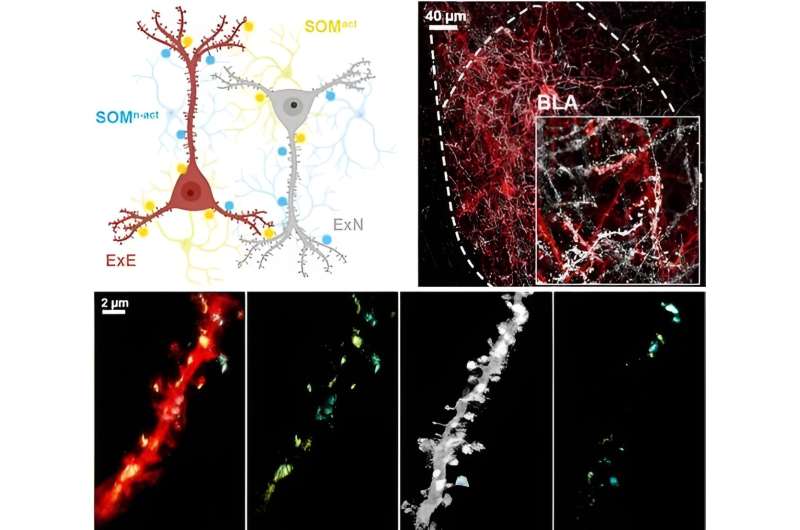This article has been reviewed according to Science X's editorial process and policies. Editors have highlighted the following attributes while ensuring the content's credibility:
fact-checked
peer-reviewed publication
trusted source
proofread
Validating the role of inhibitory interneurons in memory

Memory, a fundamental tool for our survival, is closely linked with how we encode, recall, and respond to external stimuli. Over the past decade, extensive research has focused on memory-encoding cells, known as engram cells, and their synaptic connections. Most of this research has centered on excitatory neurons and the neurotransmitter glutamate, emphasizing their interaction between specific brain regions.
To expand the understanding of memory, a research team led by KAANG Bong-Kiun (Seoul National University, Institute of Basic Science) developed a technology called LCD-eGRASP (local circuit dual-eGRASP) that can label synapses of neural circuits within a specific brain region. The team applied this new technology to identify the local synaptic connections between inhibitory interneurons and engram cells, shedding light on the role of inhibitory interneurons in memory expression.
The researchers targeted basolateral amygdala (BLA), an evolutionarily well-preserved brain region in vertebrates known for controlling positive and negative emotions in animals, especially fear. When a fear-related event occurs, neurons activated during that specific time point become engram cells, encoding the fear memory.
Subsequent activity of these engram cells in the BLA leads to a fear response during fear memory recall. The neural structure that allows signal transduction between these engram cells is called synapses, which act as a functional unit of our brain like individual transistors in semiconductor devices.
Dr. Kaang is one of the leading experts in the field of memory and engram at the synapse level. In the previous study, his group developed Dual-eGRASP (green fluorescent protein reconstruction across synaptic partners) technology that can selectively label synapses between engram cells, defined as engram synapses.
Dual-eGRASP employs cyan and yellow fluorescence to distinguish synapses formed between presynaptic and postsynaptic non-engram or engram neurons, enabling the identification of four different synaptic combinations simultaneously.
However, this technology has been limited to examining the changes between excitatory neurons and long-distance regions of the brain. To overcome this limitation, the researchers further enhanced Dual-eGRASP to develop LCD-eGRASP, a modified version that can mark local synaptic connections between neurons in a single brain region.
Researchers tested the newly developed LCD-eGRASP in mice. When the fear conditioning paradigm was used to form fear memories, a certain population of inhibitory neurons in the BLA (called somatostatin (SOM) interneurons) was activated during fear memory formation. By applying LCD-eGRASP, the researchers showed that these activated SOM interneurons formed more synapses with the fear engram cells in the BLA.
In addition, these specific SOM interneurons showed higher cellular excitability than non-activated SOM interneurons in the neutral context, indicating the suppression of fear expression occurs by inhibiting fear engram.
When fear memory was recalled, their excitability further decreased. Finally, the artificial activation or inhibition of these activated SOM interneurons resulted in direct and indirect changes in fear memory expression and behavioral responses, suggesting that inhibitory interneurons also play an important role in proper memory recall as part of an engram ensemble.
"We were able to go a step further from the previous study of excitatory engram cells and identify the role of inhibitory interneurons in regulating local brain circuits," says Dr. Kaang, the head of the research team. "This mechanism indicates that fear memories and behaviors are well controlled in normal situations and are recalled appropriately according to external stimuli."
LCD-eGRASP presents new candidates for future research on diseases, such as post-traumatic stress disorders, as memory can be controlled by regulating inhibitory interneurons. Dr. Kaang notes, "LCD-eGRASP, which can mark synapses in a local region of the brain, along with Dual-eGRASP, a conventional interregional synaptic labeling technology in the brain, will establish a core technology in the field of neuroscience."
The study is published in the journal Neuron.
More information: TaeHyun Kim et al, Activated somatostatin interneurons orchestrate memory microcircuits, Neuron (2023). DOI: 10.1016/j.neuron.2023.10.013



















